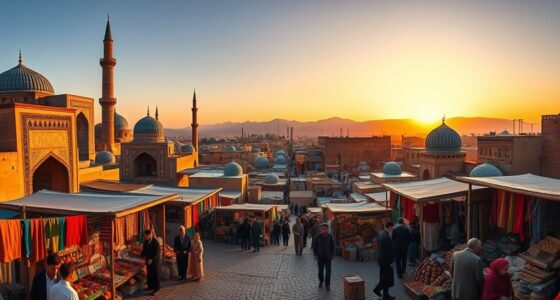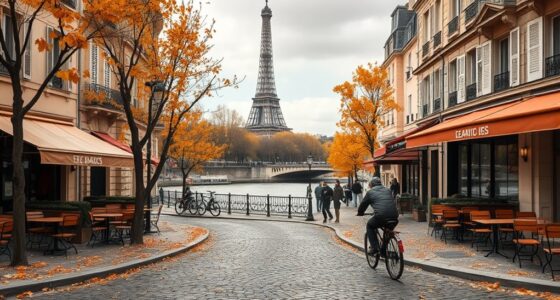In autumn, Iceland bursts with fiery fall colors, geothermal wonders, and dramatic landscapes perfect for exploring. You can chase the Northern Lights during clear, dark nights at remote spots like Jökulsárlón or Vík, while waterfalls like Skógafoss showcase rainbows amid vibrant foliage. Hot springs and volcanic terrains add to the adventure. If you keep exploring, you’ll discover even more of Iceland’s stunning natural beauty and ideal tips for your trip.
Key Takeaways
- Autumn offers vibrant fall foliage, dramatic waterfalls, geothermal hot springs, and volcanic landscapes ideal for exploration.
- Clear, dark nights in October and November provide excellent opportunities to view the Northern Lights.
- Optimal viewing spots include remote areas like Jökulsárlón Glacier Lagoon and Vík with minimal light pollution.
- Autumn weather is unpredictable; dress warmly and plan outdoor activities early for maximum daylight.
- Combining natural wonders with cultural festivals and seasonal cuisine enriches the Iceland autumn experience.
Embracing the Autumn Palette: Colors and Landscapes
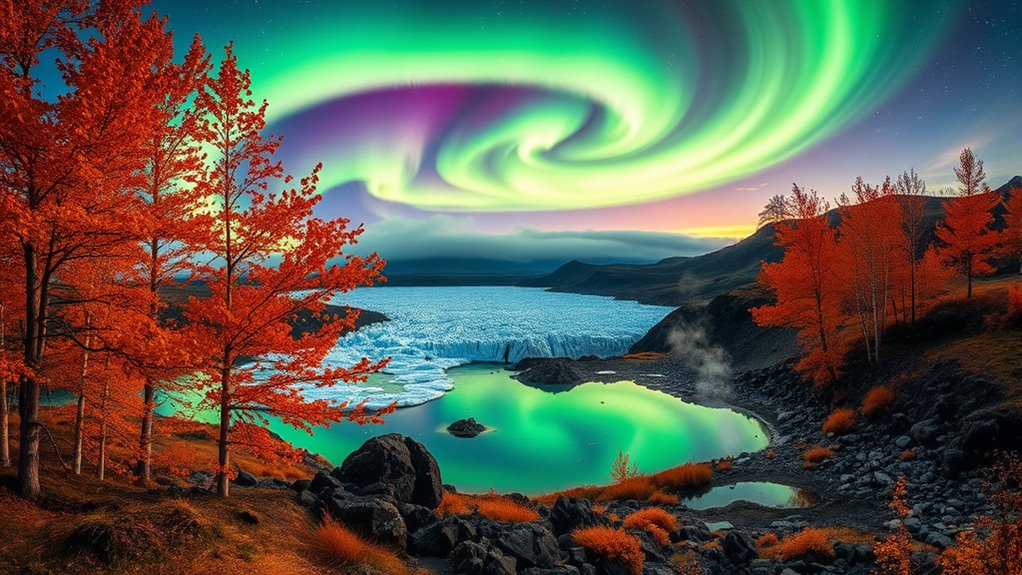
Autumn in Iceland offers a fleeting yet breathtaking display of colors and landscapes that captivate visitors. The vibrant autumn color transforms the scenery, with fiery reds, oranges, and yellows dominating valleys like Þórsmörk. You’ll notice moss green tones across volcanic terrains, adding depth and richness to the landscape textures. The stark contrast of volcanic black lava fields grounds the vibrant hues, creating a striking visual balance. As snow dusts the sky white, the seasonal shift becomes even more apparent, enhancing the landscape’s contrast. Dramatic volcanic mountain ranges silhouette against the colorful backdrop, while icy glacial valleys and winding fjords reflect the warm tones, doubling their impact. Every element combines to showcase Iceland’s unique and vivid autumn palette, making the landscape truly mesmerizing. Additionally, the interplay of natural elements in Iceland’s landscape diversity highlights the dynamic beauty and richness of the environment during this season.
Chasing the Northern Lights: Best Viewing Strategies

As the vibrant colors of Iceland’s landscapes fade into the shadows of night, spotting the Northern Lights becomes an unforgettable adventure. To maximize your chances, choose dark, remote locations like Jökulsárlón Glacier Lagoon or the Vík area, where light pollution is minimal. Dress in warm, layered cold weather gear, as you’ll be standing still for hours in chilly conditions. Use accommodations near these sites to easily access outdoor viewing spots. Join guided aurora tours for expert advice and ideal locations. Keep an eye on weather forecasts—clear skies are essential—and monitor auroral activity, especially during new moon phases. For aurora photography, set long exposures, use a sturdy tripod, and remote shutters to capture the best images of this natural spectacle. Additionally, understanding space weather conditions can help you better anticipate aurora activity, increasing your chances of witnessing this mesmerizing display.
Iconic Waterfalls and Hot Springs in Fall
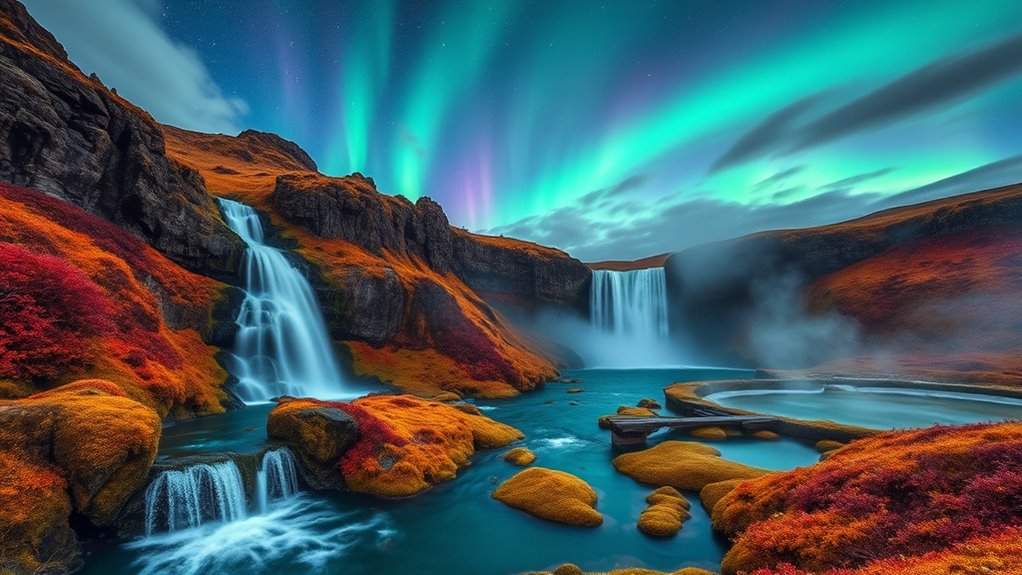
Have you ever wondered why Iceland’s waterfalls and hot springs are at their best in the fall? Autumn foliage paints the landscape in warm hues, creating stunning backdrops for waterfall photography. Skógafoss, with its 60-meter drop, offers spectacular views, especially with rainbows in the mist. Nearby trails let you explore additional waterfalls within easy reach, allowing for a more immersive experience of the natural landscape. Kirkjufellsfoss, framed by icy formations and vibrant fall colors, is perfect for capturing iconic images. Other waterfalls like Seljalandsfoss and Glymur become more accessible, with fewer crowds and clearer light. Meanwhile, hot springs such as the Secret Lagoon and Reykjadalur** provide cozy escapes amid autumnal scenery. Rising steam and crisp air make these natural baths even more inviting, making fall an ideal time to experience Iceland’s natural wonders. [The best time to visit these sites is during the autumn months, when the weather is cool and the landscape is painted in fiery reds and golds.
Exploring Iceland’s Volcanic and Geological Marvels
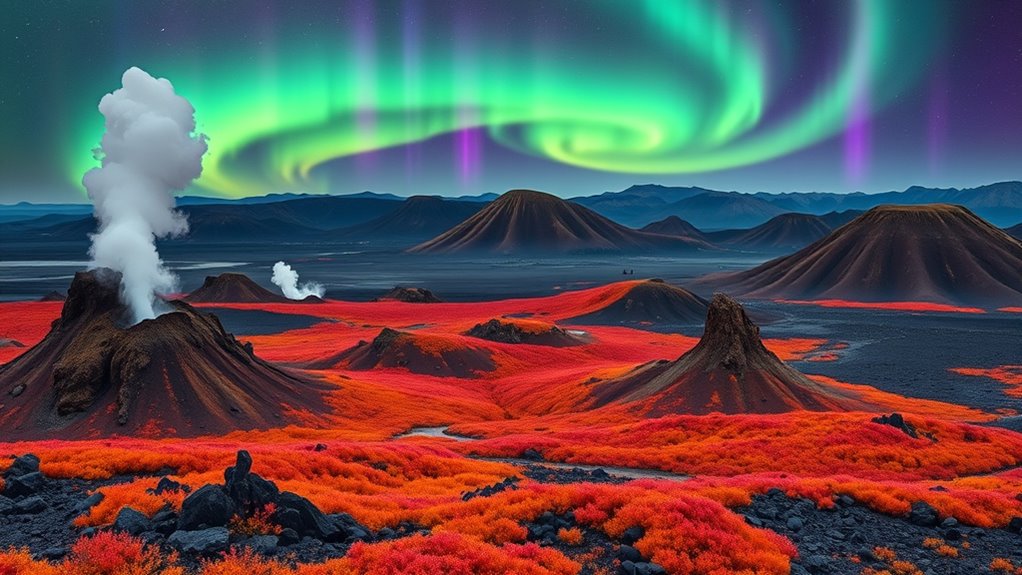
Iceland’s dramatic volcanic landscape is proof of its fiery origins and ongoing geological activity. You’ll encounter stunning volcanic formations like vast lava fields from the 1783 Laki eruption and calderas such as Krafla, showcasing collapsed craters on high plateaux. Geothermal features are everywhere, with hot springs and geysers like Geysir and Strokkur regularly erupting, revealing Iceland’s molten core. The island’s rift valleys and lunar-like craters highlight its tectonic and volcanic history. Additionally, subglacial volcanism has formed flat-topped table mountains in the north and south. The Mid-Atlantic Ridge runs through Iceland, making it a prime location to observe tectonic plate movements. Here are some highlights: 1. Extensive lava fields and lava flows 2. Calderas and rift valleys 3. Famous geysers and hot springs 4. Subglacial volcanic mountains
Wildlife Encounters During the Autumn Months
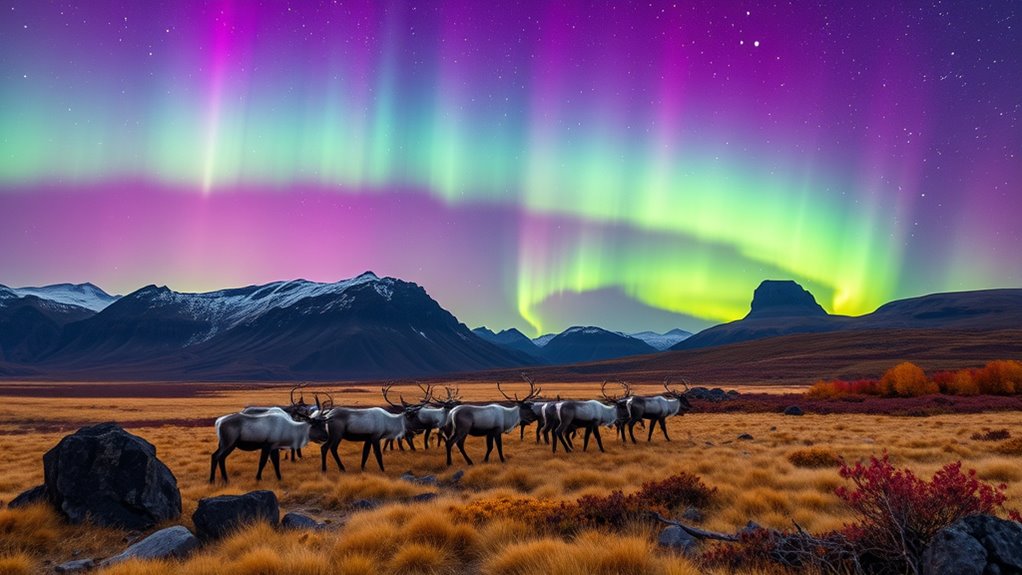
Autumn brings a dynamic shift in Iceland’s wildlife, with many species preparing for winter or beginning their migration. As you explore, you’ll notice marine mammals like minke whales and harbor seals still frequenting coastal waters, while others, like humpback whales, start migrating south, though early sightings are possible. Whale watching hotspots such as Húsavík and Skjálfandi Bay offer prime opportunities before winter closures. Birdwatching hotspots, including Lake Mývatn and coastal zones, burst with activity as migratory species like Arctic terns, oystercatchers, and golden plovers pass through. Arctic foxes increase foraging in the tundra, gathering food for winter. Reindeer remain in eastern mountain areas, and rare polar bear visitors occasionally drift in from Greenland. Wildlife activity continues despite decreased animal presence after early August. Additionally, migration patterns play a crucial role in shaping the seasonal presence of various species across Iceland’s landscapes.
Navigating the Scenic Routes and Hidden Gems

Exploring Iceland’s scenic routes reveals a landscape transformed by autumn’s vibrant hues, offering travelers unforgettable vistas and hidden treasures. As you drive along the scenic byways, you’ll encounter breathtaking autumn foliage and diverse geological wonders. Here are four must-see routes and gems:
- The Golden Circle, with Þingvellir, Geysir, and Gullfoss, all glowing with fall colors.
- South Coast drives, showcasing waterfalls and volcanic black sand beaches near Vik.
- Jökulsárlón Glacier Lagoon, where floating icebergs shimmer against autumn landscapes.
- Snæfellsnes Peninsula and North Iceland, featuring dramatic coastlines and colorful fjords.
Navigate these routes with care, as shorter daylight hours and unpredictable weather make planning essential. Many highland roads close early, so check access before heading out. Proper planning ensures you can fully enjoy these spectacular sights without surprises.
Outdoor Activities for the Adventurous Traveler

For those seeking adventure, Iceland offers a thrilling array of outdoor activities that showcase its rugged landscapes. You can try glacier hiking or ice climbing on icy peaks, exploring glacier caves like Vatnshellir, or snowmobiling across Langjökull’s glacial surface. Hiking trails near waterfalls, such as Dynjandi and Seljalandsfoss, reveal stunning scenery, while coastal hikes at Látrabjarg provide opportunities for wildlife photography of puffins and arctic foxes. Geothermal hot springs like Reykjadalur Valley offer relaxing dips after active days. You can also participate in cultural festivals celebrating local traditions. Here’s a snapshot of adventures awaiting you:
| Activity | Location | Experience |
|---|---|---|
| Glacier Hiking | Vatnajökull | Awe-inspiring icy vistas |
| Wildlife Photography | Látrabjarg | Puffins and seabirds |
| Hot Springs | Reykjadalur Valley | Soak in geothermal waters |
Additionally, the region’s diverse outdoor resources ensure travelers have plenty of options for exploration and adventure.
Planning Your Autumn Icelandic Adventure
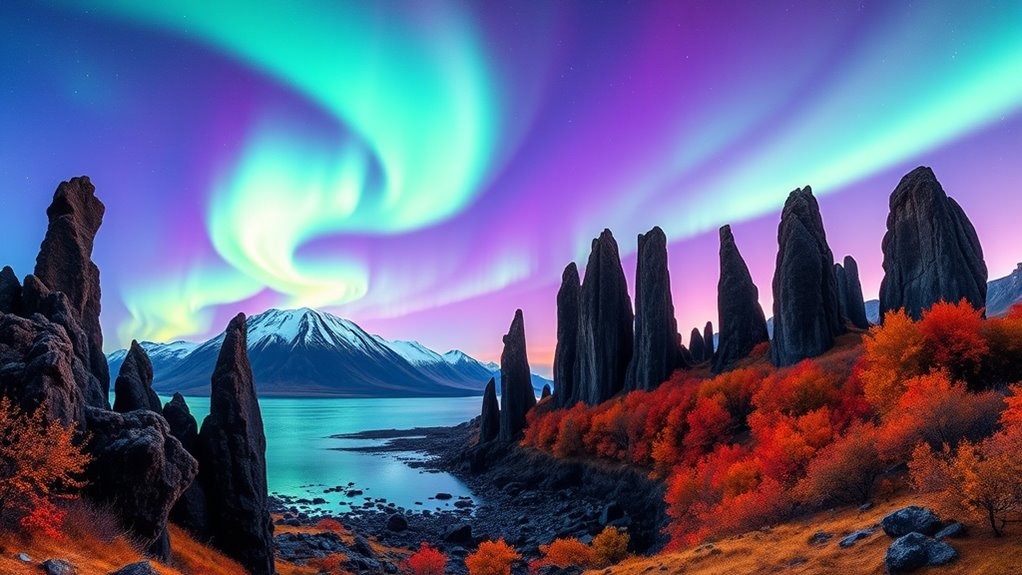
Planning your Icelandic adventure in autumn requires careful consideration of timing, weather, and daylight hours to make the most of your trip. Early September offers mild weather and fewer crowds, perfect for exploring without seasonal closures. October showcases stunning fall foliage and the start of the Northern Lights season but comes with unpredictable weather. November provides excellent Northern Lights viewing with minimal tourists, though you’ll need warm clothing for colder conditions. To maximize your experience:
Autumn in Iceland offers stunning scenery, fewer crowds, and great Northern Lights viewing—plan early for an unforgettable trip.
- Attend local autumn festivals celebrating Icelandic culture.
- Sample seasonal local cuisine like hearty stews and fresh seafood.
- Schedule outdoor activities early in the day to utilize limited daylight.
- Book accommodations in advance, especially near popular attractions.
- Consider best outdoor gear to stay comfortable and safe during variable weather conditions.
Being strategic with your planning ensures you enjoy Iceland’s natural wonders and vibrant autumn traditions fully.
Frequently Asked Questions
When Is the Best Time to See the Northern Lights in Iceland During Autumn?
You should plan your trip during mid-September to October for the best chance to see the aurora borealis forecast align with strong geomagnetic activity. These months offer longer nights, darker skies, and favorable weather, making aurora viewing more likely. Keep an eye on the aurora forecast, and consider the autumn foliage timing, as clear, crisp nights amid colorful landscapes enhance your experience and increase your chances of witnessing the Northern Lights.
Are All Roads Accessible for Driving in Iceland During the Autumn Months?
You should know that not all roads are accessible in Iceland during autumn. Road conditions change rapidly, especially in fjord regions and highlands, with F-roads and interior routes often closed due to snow and unsafe conditions. For your vehicle rentals, a 4×4 or AWD vehicle is highly recommended for safer travel. Always check local updates before driving, as some roads might be temporarily closed or become slippery, affecting your plans.
How Do Weather Conditions Affect Outdoor Activities in Iceland in Fall?
Weather unpredictability, autumn foliage, and changing conditions greatly influence your outdoor activities. You’ll face rain, hail, or snow, making trails slippery and sometimes inaccessible. Wind and rapidly shifting weather demand waterproof gear, layered clothing, and flexibility in plans. Shortening daylight hours limit your outdoor time, while unpredictable weather can surprise you. Stay prepared, monitor forecasts, and choose your activities early in the day to enjoy Iceland’s fall wonders safely.
Can I Visit Iceland’S Highlands in Autumn, and Are Roads Open?
You can’t access Iceland’s Highlands in autumn because F-road closures happen from mid-September to mid-October, making Highland adventures impossible. The autumnal landscapes are stunning, but dangerous weather conditions, snow, and river crossings limit travel beyond main roads. If you want to explore, focus on accessible areas like the Ring Road, Westfjords, or Golden Circle. Be prepared for rapidly changing weather, and always check road conditions before heading out for a safe and enjoyable trip.
What Should I Pack for Iceland’S Variable Autumn Weather?
For Iceland’s variable autumn weather, your autumn wardrobe should include layered clothing like thermal base layers, waterproof outerwear, and warm accessories such as hats and gloves. Packing essentials also involve sturdy waterproof boots, quick-dry socks, and a rain cover for electronics. Don’t forget a small backpack, power bank, and travel first aid kit. Being prepared with versatile gear helps you stay comfortable and enjoy your adventures despite unpredictable weather changes.
Conclusion
As autumn in Iceland invites you to immerse in its icy intrigues, embrace the mesmerizing environment and explore every extraordinary element. From vivid valleys to vibrant vistas, let your adventure be fueled by fascination and freedom. Chase the enthralling colors, hunt for heavenly lights, and uncover hidden havens. With wonder waiting at every turn, wander boldly and let Iceland’s incredible landscapes leave an indelible impression on your adventurous spirit.



